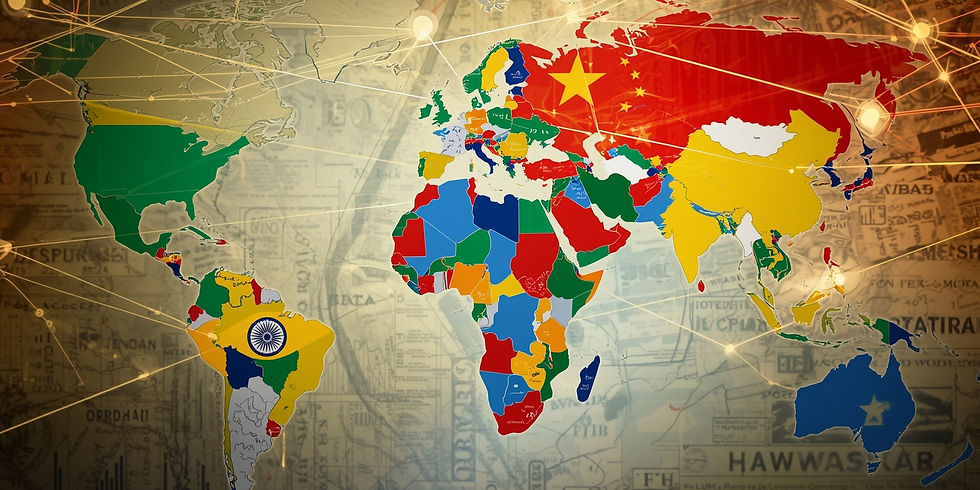What brings the BRICS closer to Bretton Woods thinking?
- Antonio Carlos Faustino

- Aug 8
- 4 min read

Introduction
The term BRICS Bretton Woods may sound contradictory, as one represents the current challenge to the global financial order and the other symbolizes the economic pact that shaped the world after World War II. However, a closer look reveals important points of convergence—especially in the vision of creating multilateral structures to stabilize trade, monetary, and investment flows.
This article analyzes in depth how BRICS initiatives interact with the economic governance model born in Bretton Woods in 1944, exploring historical data, institutional mechanisms, convergences and divergences, and the impact on the Americas.
1. Bretton Woods: objectives and operation
1.1 Historical context
Between July 1 and 22, 1944, in the small town of Bretton Woods, New Hampshire (USA), 44 countries met to establish rules that would prevent financial crises like the one in 1929 and avoid the exchange rate chaos that had favored the advancement of nationalist policies and wars.
1.2 Main pillars
The Bretton Woods Agreement established three foundations:
Fixed exchange rates , with currencies pegged to the dollar and the dollar to gold (US$35 per troy ounce).
Multilateral institutions for financial support and reconstruction — the International Monetary Fund (IMF) and the International Bank for Reconstruction and Development (IBRD, now the World Bank).
Promotion of international trade as a vector of stability and growth.
According to Helleiner (2014), the system represented “managed capitalism” , in which States played an active role in controlling the global economy.
2. BRICS and its institutions
2.1 Origin and expansion
The term BRIC was coined by Goldman Sachs economist Jim O'Neill in 2001 to designate Brazil, Russia, India, and China—emerging economies with significant growth potential. South Africa joined in 2010, forming the BRICS.
2.2 Institutional structures
The New Development Bank (NDB) , created in 2014, and the Contingent Reserve Arrangement (CRA) are the bloc's most relevant financial mechanisms.
The NDB finances infrastructure and sustainable development projects, often in local currency, reducing foreign exchange exposure.
The ACR is a liquidity fund to help member countries face balance of payments pressures, with initial capital of US$100 billion.
3. BRICS Bretton Woods Convergence Points
3.1 Institutionalized multilateralism
Just as Bretton Woods structured the IMF and the World Bank, the BRICS are building their own institutions to coordinate financial and development policies. The BRICS Bretton Woods upholds the logic that formal and institutional cooperation is essential for stability.
3.2 Search for monetary stability
The Bretton Woods fixed exchange rate and the BRICS swap and reserve lines are based on the same principle: to avoid volatility that compromises trade and investment.
3.3 Economic integration
Both systems prioritize economic integration as a mechanism for peace and prosperity. Bretton Woods did this through the General Agreement on Tariffs and Trade (GATT); BRICS through bilateral trade agreements and encouraging the use of national currencies.
4. Structural differences
Despite the convergences, there are fundamental distinctions:
Monetary base : Bretton Woods had the dollar backed by gold; BRICS does not propose a fixed exchange rate, but encourages agreements in local currencies and the study of a joint digital currency.
Leadership : Bretton Woods was led by the US and the UK; BRICS operates with shared leadership, but with China's increasing influence.
Geopolitical scope : Bretton Woods sought to rebuild the West; BRICS aims for global multipolarity.
5. Implications for the Americas
For Latin America, the BRICS Bretton Woods connection offers opportunities and risks:
Access to alternative financing (via NDB) with fewer conditionalities than the IMF.
Monetary diversification that can reduce vulnerability to the dollar, especially for countries with strong trade with China and India.
Diplomatic tensions between historical alignment with the US and new partnerships with BRICS.
6. Suggested visuals
Main image : World map highlighting BRICS countries against a historic Bretton Woods Conference background. Alt text : “Map connecting BRICS countries and historic Bretton Woods Conference sites.”
Comparative chart : Timeline with main events of Bretton Woods (1944-1971) and BRICS (2001-2025).
Infographic : Comparison between IMF/World Bank and NDB/ACR in terms of capital, governance and objectives.
7. Recommended products
Book : The Battle of Bretton Woods – Benn Steil . Buy on Amazon
Book : The BRICS and the Future of Global Order . Buy on Amazon
Illuminated Geopolitical Globe – Decorative and Functional . Buy on Amazon
8. Conclusion: the new version of the pact
The analysis shows that BRICS Bretton Woods is not a contradiction, but rather an evolution. Both share the notion that strong multilateral institutions are key to economic stability. The difference lies in the geopolitical design: while Bretton Woods centralized power in the West, BRICS proposes distributing it in a multipolar world.
References
HELLEINER, Eric. Forgotten Foundations of Bretton Woods: International Development and the Making of the Postwar Order . Ithaca: Cornell University Press, 2014.
STEIL, Benn. The Battle of Bretton Woods: John Maynard Keynes, Harry Dexter White, and the Making of a New World Order . Princeton: Princeton University Press, 2013.
O'NEILL, Jim. Building Better Global Economic BRICs . Goldman Sachs Global Economics Paper No. 66, 2001. Available at: https://www.goldmansachs.com/insights/archive/brics-book.html . Accessed on: August 8, 2025.
NDB – NEW DEVELOPMENT BANK. Annual Report 2024 . Shanghai: NDB, 2024. Available at: https://www.ndb.int . Accessed on: August 8, 2025.
INTERNATIONAL MONETARY FUND – IMF. Articles of Agreement of the International Monetary Fund . Washington, DC: IMF, 1944. Available at: https://www.imf.org . Accessed on: August 8, 2025.
WORLD BANK. Bretton Woods Conference, 1944 . Washington, DC: World Bank Group Archives, 2024. Available at: https://www.worldbank.org . Accessed on: August 8, 2025.
BRICS. Johannesburg II Declaration . Johannesburg: BRICS Summit, 2023. Available at: https://brics2023.gov.za . Accessed on: August 8, 2025.
UNITED NATIONS. Charter of the United Nations . San Francisco: UN, 1945. Available at: https://www.un.org . Accessed on: August 8, 2025.
GATT – GENERAL AGREEMENT ON TARIFFS AND TRADE. Text of the General Agreement . Geneva: GATT Secretariat, 1947. Available at: https://www.wto.org . Accessed on: August 8, 2025.




Comments